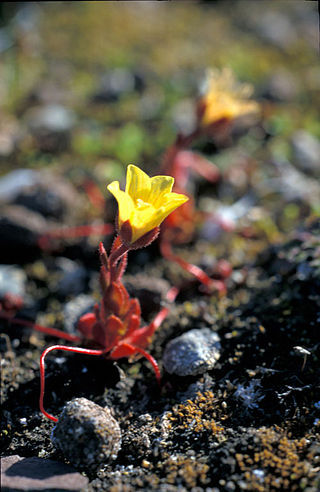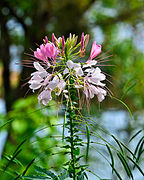
Saxifraga is the largest genus in the family Saxifragaceae, containing about 465 species of holarctic perennial plants, known as saxifrages or rockfoils. The Latin word saxifraga means literally "stone-breaker", from Latin saxum + frangere. It is usually thought to indicate a medicinal use for treatment of urinary calculi, rather than breaking rocks apart.

Chlorophytum comosum, usually called spider plant or common spider plant due to its spider-like look, also known as spider ivy, ribbon plant, and hen and chickens is a species of evergreen perennial flowering plant of the family Asparagaceae. It is native to tropical and Southern Africa but has become naturalized in other parts of the world, including Western Australia and Bangladesh. Chlorophytum comosum is easy to grow as a houseplant because of its resilience, but it can be sensitive to the fluoride in tap water, which commonly gives it "burnt tips". Variegated forms are the most popular.

Dracaena sanderiana is a species of flowering plant in the family Asparagaceae, native to East asia and South East Asia. It was named after the German–English gardener Henry Frederick Conrad Sander (1847–1920). The plant is commonly marketed as "lucky bamboo".

Saxifraga flagellaris, the whiplash saxifrage or flagellate saxifrage, is a plant native all over the Eurasian Arctic Coast, Siberia, Far East, Caucasus and some areas of northern Rocky Mountains. It is not very common. It is also known as spider saxifrage or "spider plant", though the latter name more commonly refers to the unrelated Chlorophytum comosum (Agavaceae).

Chlorophytum, is a genus of almost 200 species of evergreen perennial flowering plants in the century plant subfamily within the asparagus family. The plants are native to the tropical and subtropical regions of Africa, Australia, and Asia.
Beeplant is a common name for several plants and may refer to:

Cleome is a genus of flowering plants in the family Cleomaceae, commonly known as spider flowers, spider plants, spider weeds, or bee plants. Previously, it had been placed in the family Capparaceae, until DNA studies found the Cleomaceae genera to be more closely related to the Brassicaceae than the Capparaceae. Cleome and clammyweed can sometimes be confused. The simplest way to differentiate the two is to compare the seedpods which project out or down on cleome and up on clammyweed.
Spider flower may refer to plant species within the genus Cleome including:
Bladderpod is a common name for several plants and may refer to:
Alpine saxifrage is a common name for several different plants and may refer to:
Saxifrage or Saxifraga a plant genus.
Wild spinach is a common name for several plants with edible leaves and may refer to:
Roving sailor most commonly refers to:
Mother of thousands is a common name for several plants, including:

Hen and chicken is a common name for several unrelated groups of plants. The name refers to the tendency of certain of these species to reproduce vegetatively by means of plantlets. These tiny plants are produced by the mother plant, and take root on touching the ground.
Sinapistrum can be one of these two plant genera:
This page is based on this
Wikipedia article Text is available under the
CC BY-SA 4.0 license; additional terms may apply.
Images, videos and audio are available under their respective licenses.









